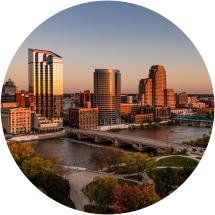The Gerald R. Ford International Airport (GFIA, or GRR as it is known locally) became home to an impressive art collection as part of its commitment to highlight and support the thriving art culture in the Grand Rapids area.
The installations — all created by local artists — are displayed on pedestals, painted on the walls, embedded in the floors or hanging from the ceiling. They are spread throughout the facility from the lobby to the concourses, funded through a partnership with the Frey Foundation aimed at prioritizing the inclusion of art at the airport.
“Through our art program, we strive to curate a unique sense of place that resonates with our community,” said Tory Richardson, Gerald R. Ford International Airport Authority president and CEO. “With millions of travelers passing through the airport each year, we are delighted to showcase the diverse talents that exist in West Michigan.
“Our art program is committed to highlighting the landscape of West Michigan, from the lakeshore to the urban core, sharing the natural beauty of our region and inspiring travelers from around the world.”
The Frey Foundation partnership means the art committee is part of all renovation and expansion discussions. That includes the recent expansion of Concourse A, which is nearing completion and features 10 new works from local artists.

Nick Nortier's mural, "The Great Blue," pays homage to West Michigan's blue heron and the Great Lakes.
Photo by Brian Craig for Experience GR. Artwork: The Great Blue by Nick Nortier.
Natural beauty, vibrant city
The first pieces created through the program were two murals painted in 2020. The Great Blue, is an ode to the blue heron and the Great Lakes painted by Grand Rapids native Nick Nortier. It’s featured on a large wall leading to Concourse B.
“This mural is one of the largest interior walls I have ever painted and in an area with an immense amount of foot traffic — thousands of people come through every day,” Nortier said when it was completed in March 2020. “I am excited to have this opportunity to leave my mark at the Gerald R. Ford International Airport.”
The second was created by Grand Rapids artist Reb Roberts, whose brightly colored folk art is found across the city. Reb painted “Chickens Don’t Fly Too Much” on the walkway to Concourse A. The multi-colored, 80-foot-long piece features his signature stylized animals, stars and flowers. Reb said he hopes people see the vibrant, active mural and connect it to the city.
“I would like people to see that Grand Rapids, whether they’re coming or going, is a pretty vibrant place that has a lot going on. It’s colorful even though it doesn't always get painted that way.”

Jason Quigno's 9-foot-tall stone sculpture, representing Anishinaabek culture, is on display in the airport's main lobby.
Photo by Brian Craig for Experience GR. Artwork: Aankobiisinging Eshki-kakamigak by Jason Quigno.
Celebrating Michigan’s native peoples
In 2021 a stone sculpture was installed as part of the program. The 9-foot-tall Aankobiisinging Eshki-kakamigak, or Connection to Creation, by Anishinaabe artist Jason Quigno, sits on a pedestal in the main lobby. Carved from black granite and Indiana limestone, it celebrates the rich culture and history of native peoples in West Michigan.
The base features a turtle with Anishinaabe floral design representing the four cardinal directions. On top of the turtle’s shell sits a second feature of fire and flames flowing upward in a spiral pattern suggesting smoke. The pinnacle features four eagles with their mouths slightly open.
“The turtle, or mizkeekay, and its shell represent the land we inhabit,” Jason explained. “She is the base the fire and flames sit upon. Fire, or ishkoday, is important to the Anishinaabek – through the fire and smoke, our prayers flow up to the creator. Finally, the four eagles, or migiizis, represent and acknowledge the four cardinal directions. The eagles are said to carry those prayers to the creator.”
Jason said his intention was to “share a portion of the Anishinaabek’s beautiful history, our stories and rich traditions in stone. I made this for the airport and its visitors, but also for my Anishanabe people, for them to feel proud.”

The airports concourse is surrounded by artwork on the floor and hanging from the ceiling.
Photo by Bryan Esler for Gerald R. Ford International Airport
From the lake to the city
Four sections of custom terrazzo flooring were unveiled in 2023 with the opening of the renovated and expanded Concourse A. They were designed to follow your journey to the area beginning at Lake Michigan and taking you east into the city of Grand Rapids.
It starts with blue hues to represent the water, browns and tans take you through the beaches and dunes, greens highlight the area’s agriculture and forests and finally shades of purple greet you at the city.
When creating his water elements using different shades of blues and white in his flooring design, George Everhardt III was inspired by The Great Wave off Kanagawa, an iconic piece by Katsushika Hokusai.
Maureen Nollette created the rolling dunes and native plant experience guided by a photograph she took of a Michigan beach scene. Michael Pfleghaar used a collection of plein air paintings to inspire his depiction of the area’s forests and agriculture. And finally Kim Nguyen wrapped up the journey with a piece that referenced the city and its surrounding communities.
“I am overjoyed and feel incredibly honored to be one of the artists helping new residents and future travelers see the beauty of our home through artwork beneath their feet,” Nguyen told the airport. “I have always felt a fondness for airports because they bring me the thrill of travel, and in the case of Ford International Airport, the relieving feeling of being almost home.”
More murals underway
As the finishing touches are put on the renovations to Concourse A, travelers will see five new murals and three suspended sculptures. The murals are Welcome to West Michigan by AK Bueno, Manitou Passage by Maddison Chaffer, Hauling in the Sail by Jimmy Cobb, “Returning to Earth” by Jill Eggers and Twilight on the Rapids by Devin Dumond.
The suspended art, titled Facets, will be created by Jeffrey Augustine Songco. It features three separate installations of multiple strands of different colored shapes hanging from the ceiling.
“Like the sparkling gems of a necklace, this work is colorful and flashy,” Songco said in a statement. “I’ve had the privilege of engaging with local residents, workers and visitors in a variety of ways and ‘Facets’ is a celebration of the different and beautiful faceted gems of our community.
"I’m truly honored to create artwork that depicts a story about West Michigan.”

Reb Roberts created "Chickens Don't Fly Too Much" to symbolize the vibrant and colorful place Grand Rapids is.
Photo by Brian Craig for Experience GR. Artwork: Chickens Don’t Fly Too Much by Reb Roberts.
Honoring the airport’s namesake
Visitors can also see art pieces honoring former President Gerald R. Ford, who was raised in Grand Rapids. A large mural created in 1975 honoring the former president is displayed on the east end of the terminal, perfectly situated to welcome international travelers. Celebrated Grand Rapids artist Paul Collins was commissioned to create the mural, which depicts highlights of Ford’s life and presidency.
The former president is also honored in the Presidential Gateway Plaza outside the airport entrance. It features a large circular bench complete with a bronze statue of the former president welcoming travelers.
The statue is part of the Community Legends Sculpture Project, an ongoing initiative to erect 25 bronze statues honoring people who helped shape Grand Rapids. (You can see several others on a walking tour of the city!)
Another piece of art connected to the former president is a model plane painted by Alexander Calder, the creator of La Grande Vitesse sculpture installed outside City Hall. Calder painted the plane, titled “Flying Colors of the United States,” as part of his work commemorating the country’s bicentennial.
The design was recreated on a Boeing 727, which was dedicated at a ceremony in Washington D.C. presided over by First Lady Betty Ford. The model plane, given to the city when the real plane flew into Grand Rapids, is on display with a small-scale model of La Grande Vitesse.
To learn more about the airport’s art project, visit their website.



